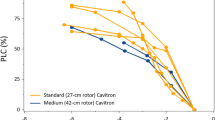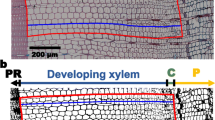Abstract
Axial water transport in trees is mainly determined by the gradient of negative water pressure and the structure of conductive xylem elements (i.e. conduits) connecting the fine roots with the foliage. There is still an essential lack of knowledge concerning the relationship between wood structure and hydraulic properties, especially of coarse roots. To this end, the study aimed (1) to work out a novel approach, based on the combination of computer tomography (CT) and light microscopy (LM), for determining the cumulative cross-sectional lumen area of conduits involved in the water transport of coarse roots in European beech (Fagus sylvatica) and Norway spruce (Picea abies) and (2) to demonstrate its adequacy in quantifying the functional relationship between sapwood anatomy and ascending water mass flow in the xylem. The cross-sectional sapwood area of coarse roots was assessed through CT. The cumulative cross-sectional lumen area of conduits in the sapwood (i.e. the lumen area of conductive conduits) was measured by LM in combination with interactive image analysis. The new approach was developed with coarse roots of both the tree species growing in a 60-year-old mixed forest in Bavaria, Germany. The combination of the two methods unveiled spruce to possess a distinct sapwood/heartwood boundary in small-diameter roots, whereas such roots of beech reflected a gradual transition zone; only large-diameter roots displayed a distinct boundary in beech. Additionally, the cumulative lumen area of conductive conduits was found to be approximately 12% of the total coarse root cross-sectional area in both the tree species. The new approach of measuring the conductive lumen area of coarse-root conduits yielded levels of specific sap flow (i.e. axial conductivity) that substantially differed from those derived from commonly applied methods, which were based on sap flow per unit of total cross-sectional root area or xylem cross-sectional area of individual roots. The combination of CT and LM will facilitate functional comparisons of woody roots differing in diameter and of tree species of different anatomical xylem structure.





Similar content being viewed by others
References
Bhandarkar SM, Faust TD, Tang M (1999) CATALOG: a system for detection and rendering of internal log defects using computer tomography. Mach Vis Appl 11:171–190
Čermak J, Kučera J (1987) Transpiration of fully grown trees and stands of spruce (Picea abies (L.) Karst.) estimated by the tree-trunk and balance method. In: Swanson RH, Bernier PY, Woodward PD (eds): Forest hydrology and watershed measurements, Proceedings of the Vancouver, Canada, Publ. no. 167, Wallingford, pp 311–317
Čermak J, Kučera J, Nadezhdina N (2004) Sap flow measurements with some thermodynamic methods, flow integration within trees and scaling up from sample trees to entire forest stands. Trees 18:529–546
Coners H (2001) Wasseraufnahme und artspezifische hydraulische Eigenschaften der Feinwurzeln von Buche, Eiche und Fichte: in situ Messungen an Altbäumen. Dissertation, Mathematisch-Naturwissenschaftliche Fakultät der Georg-August-Universität zu Göttingen, p 118
Fromm JH, Sautter I, Matthies D, Kremer J, Schumacher P, Ganter C (2001) Xylem water content and wood density in spruce and oak trees by high-resolution computer tomography. Plant Physiol 127:416–425
Gansert D, Sprik W (1998) Storage and mobilization of nonstructural carbohydrates and biomass development of beech seedlings (Fagus sylvatica L) under different light regimes. Trees 12(5):247–257
Grime JP (1977) Evidence for the existence of three primary strategies in plants and its relevance to ecological and evolutionary theory. Am Nat 111:1169–1194
Haskins JL, Ford ED (1990) Flow through conifer xylem: modeling in the gap between spatial scales. In: Dixon RK, Meldahl RS, Ruark GA, Warren WG (eds) Process modeling of forest responses to environmental stress. Timber Press, Portland, pp 58–63
Huang B, Nobel PS (1994) Root hydraulic conductivity and its components, with emphasis on desert succulents. Agron J 86:767–774
Huber B, Prütz G (1938) Über den Anteil von Fasern, Gefäßen und Parenchym am Aufbau verschiedener Hölzer. Holz als Roh-und Werkstoff 10:377–381
Korn S (2004) Experimentelle Untersuchung der Wasseraufnahme und der hydraulische Eigenschaften des Wurzelsystems von sechs heimischen Baumarten. Dissertation, Mathematisch-Naturwissenschaftliche Fakultät der Georg-August-Universität zu Göttingen, p 158
Larcher W (2001) Ökophysiologie der Pflanzen. Ulmer, Stuttgart, p 204
Leuschner CH, Coners H, Icke R (2004) In situ measurement of water absorption by fine roots of three temperate trees: species differences and differential activity of superficial and deep roots. Tree Physiol 24:1359–1367
Lindenmair J, Matzner E, Zimmermann R (2004) The role of woody roots in water uptake of mature spruce, beech, and oak trees. Ecol Stud 172:279–289
Lindgren O (1991) Medical CAT-scanning: X-ray absorption coefficients, CT-numbers and their relation to wood density. Wood Sci Technol 25:341–349
Longuetaud F, Mothe F, Leban J-M, Mäkelä A (2006) Picea abies sapwood width: variations within and between trees. Scand J For Res 21:4–53
Lott JE, Khan AAH, Ong CK, Black CR (1996) Sap flow measurements of lateral tree roots in agroforestry systems. Tree Physiol 16:995–1001
Nadezhdina N (1999) Sap flow index as an indicator of plant water status. Tree Physiol 19:885–891
Nikolova PS (2007) Below-ground competitiveness of adult beech and spruce trees: resource investments versus returns. Ph.D. thesis, Ecophysiology of Plants, Technische Universität München, Freising, p 161
North GB, Nobel PS (1994) Changes in root hydraulic conductivity for two tropical epiphytic cacti as soil moisture varies. Am J Bot 81(1):46–53
Ong CK, Deans JD, Wilson J, Mutua J, Khan AAH, Lawson EM (1998) Exploring below ground complementarity in agroforestry using sap flow and root fractal techniques. Agrofor Syst 44:87–103
Patzner KM (2004) Die Transpiration von Waldbäumen als Grundlage der Validierung und Modellierung der Bestandestranspiration in einem Wassereinzugsgebiet des Flusses “Ammer”. Ph.D. thesis, Ecophysiology of Plants, Technische Universität München, Freising, p 168
Pretzsch H, Schütze G (2008) Transgressive overyielding in mixed compared with pure stands of Norway spruce and European beech in Central Europe: evidence on stand level and explanation on individual tree level. Eur J Forest Res. doi:10.1007/s10342-008-0215-9
Pretzsch H, Kahn M, Grote R (1998) Die Fichten-Buchen-Mischbestände des Sonderforschungsbereiches “Wachstum oder Parasitenabwehr?” im Kranzberger Forst. Forstw Centr 117:201–207
Riedl H (1937) Bau und Leistungen des Wurzelholzes. Dissertation der Forstlichen Hochschule Tharandt, Abteilung der Technischen Hochschule Dresden, p 75
Rötzer T, Seifert T, Pretzsch H (2008) Modelling above and below ground carbon dynamics in a mixed beech and spruce stand influenced by climate. Eur J Forest Res. doi:10.1007/s10342-008-0213-y
Sandberg K (2004) Water absorption and desorption in Norway spruce and its influence on durability. Lic. thesis at the Luleå Tekniska Universitet, Skellefteå, Sweden, LTU 2004: 16 ISSN, pp 1402–1757
Schweingruber FH (2001) Dendroökologische Holzanatomie—anatomische Grundlagen der Dendrochronologie. Haupt Verlag, Bern, p 472
Seifert T, Müller-Starck (2008) Impacts of fructification on biomass production and correlated genetic effects in Norway spruce (Picea abies [L.] Karst.). Eur J Forest Res. doi:10.1007/s10342-008-0219-5
Seifert T, Fürst C, Seifert S, Knoke T (2008) Improving red rot and red heart prediction by modeling sapwood in Norway spruce and European beech. Proceedings of the IUFRO Working Party 5.01.04 on “Wood quality modelling”, Waiheke, New Zealand, 20–27 November 2005 (in press)
Senock RS, Ham JS (1993) Heat balance sap flow gauge for small diameter stems. Plant Cell Environ 16:593–601
Senock RS, Leuschner C (1999) Axial water flux dynamics in small diameter roots of a fast growing tropical tree. Plant Soil 208:57–71
Smith DM, Jackson NA, Roberts JM, Ong CK (1999) Reverse flow of sap in tree roots and downward siphoning of water by Grevillea robusta. Funct Ecol 13:256–264
Steudle E (2001) The cohesion-tension mechanism and the acquisition of water by plant roots. Annu Rev Plant Physiol Plant Mol Biol 52:847–875
Stöhr A, Lösch R (2004) Xylem sap and drought stress of Fraxinus excelsior saplings. Tree Physiol 24:169–180
Tyree MT (2003) Hydraulic limits on tree performance: transpiration, carbon gain and growth of trees. Trees 17:95–100
Tyree MT, Ewers FW (1991) The hydraulic architecture of trees and other woody plants. New Phytol 119:345–360
Tyree MT, Zimmermann MH (2002) Xylem structure and the ascent of sap. Springer, Germany, p 283
Tyree MT, Velez V, Dalling JW (1998) Growth dynamics of root and shoot hydraulic conductance in seedlings of five neotropical tree species: scaling to show possible adaptation to differing light regimes. Oecologia 114(3):293–298
Vötter D (2005) Splintholzerkennung mittels Computertomographie und Färbeverfahren an Fichte und Buche. Ein Methodenvergleich. Diploma thesis at the Chair of Forest Yield Science, Technische Universität München, Freising, p 151
Wagner KR, Ewers FW, Davis SD (1998) Tradeoffs between hydraulic efficiency and mechanical strength in the stems of co-occurring species of chaparral shrubs. Oecologia 117:53–62
Wipfler P, Seifert T, Heerdt C, Werner H, Pretzsch H (2005) Growth of adult norway spruce (Picea abies [L.] Karst.) and European Beech (Fagus sylvatica L.) under free-air ozone fumigation. Plant Biol 7:611–618
Zeier J, Schreiber L (1998) Comparative investigation of primary and tertiary endodermal cell walls isolated from the roots of 5 monocotyledonous species: chemical composition in relation to fine structure. Planta 206:349–361
zu Castell W, Schrödl S, Seifert T (2005) Volume interpolation of CT images from tree trunks. Plant Biol 7:737–744
Acknowledgments
This research was accomplished within the framework of the collaborative research centre SFB 607 “Growth and Parasite Defence”, funded by the German Research Foundation (DFG). The authors would also like to thank Siemens AG for the donation of the CT device and the following persons who contributed in various ways: Mr. Erich Seifert for support with image analysis, Mrs. Johanna Lebherz and Ing. Thomas Feuerbach for diligent technical assistance and Mr. Iain Barbary for thorough language revision.
Author information
Authors and Affiliations
Corresponding author
Additional information
Communicated by A. Roloff.
Petia S. Nikolova and Thomas Seifert contributed equally to this work.
This article belongs to the special issue “Growth and defence of Norway spruce and European beech in pure and mixed stands”.
T. Seifert was formely Chair of Forest Yield Science, Technische Universität München.
Rights and permissions
About this article
Cite this article
Nikolova, P.S., Blaschke, H., Matyssek, R. et al. Combined application of computer tomography and light microscopy for analysis of conductive xylem area in coarse roots of European beech and Norway spruce. Eur J Forest Res 128, 145–153 (2009). https://doi.org/10.1007/s10342-008-0211-0
Received:
Revised:
Accepted:
Published:
Issue Date:
DOI: https://doi.org/10.1007/s10342-008-0211-0




